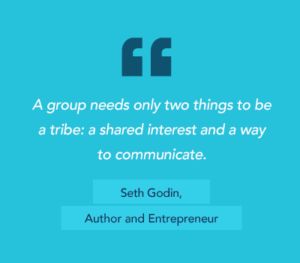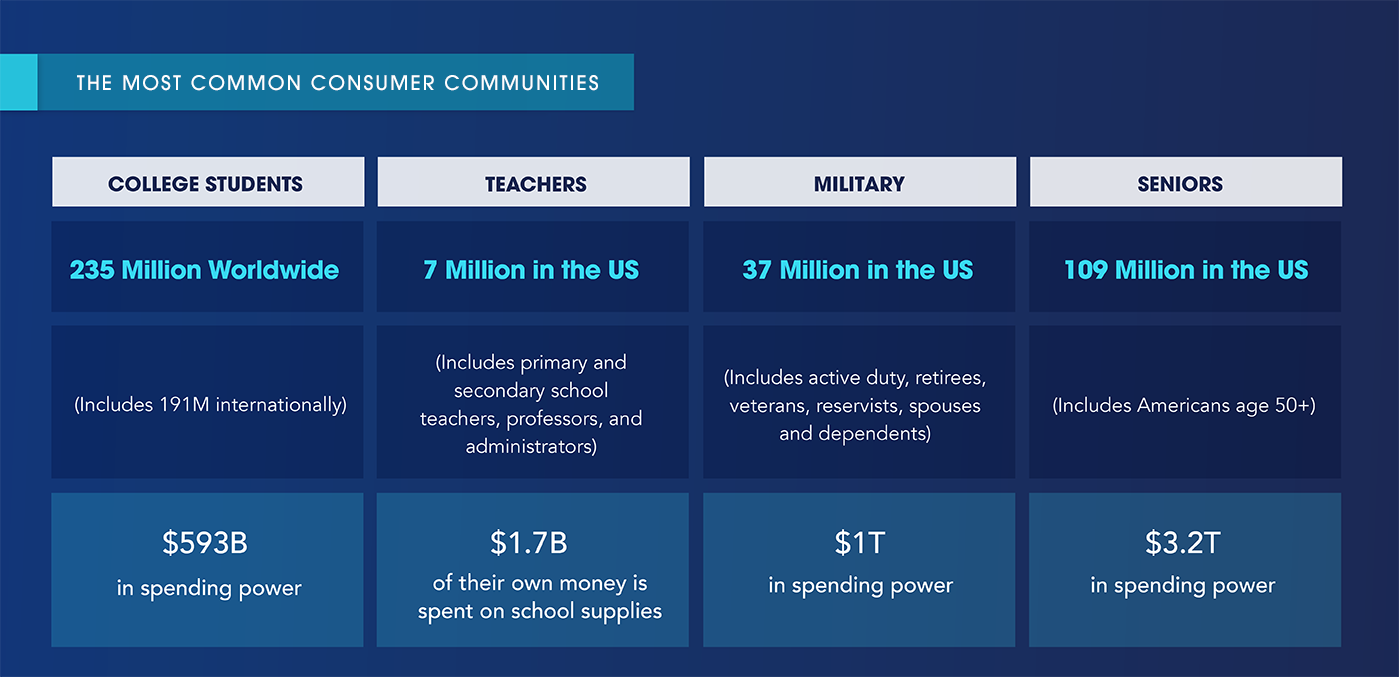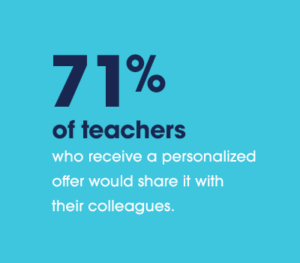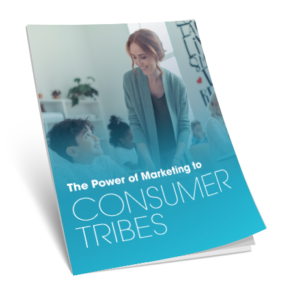What Is Consumer Community Marketing
Consumer Community marketing is an effective strategy for acquiring high-value customers who are likely to become repeat purchasers. It goes beyond traditional market segmentation—which just relies on demographic traits, behaviors, and geographies—and engages customers based on an important aspect of their identity such as vocation, orientation, activities, interests, and perspectives.
Groups that share an identity-based attribute are called consumer communities. Examples of consumer communities include members of the military, college students, extreme sports enthusiasts, environmentalists, seniors, and teachers. To engage consumer communities, companies align their brand promise and brand integrity with what these customers value. Because members of consumer communities are deeply connected, engaging them can trigger word-of-mouth marketing through social media or personal recommendations in a way that typical segmentation never could.

Consumer communities have tremendous purchasing power:
- The US military community has 37 million members and $1 trillion in spending power.
- The US has nearly four million teachers who spend $1.7 billion of their own money on school supplies alone.
- Globally, there are 235 million college students. US students have more than $574 billion in spending power.
- In the United States, 109 million seniors have $3.2 trillion in spending power.
The nearly four million nurses in the US. are well-paid: The average salary for a Registered Nurse (RN) is $74,000, and in some states nears, or is above, six figures.
In this article, we’ll discuss how consumer community marketing works, the benefits of consumer community marketing, examples of consumer community advertising, and how a new form of personalization called identity marketing uses the consumer community idea to virally spread the word of your message and offer.

How Consumer Community Marketing Works
Humans have a deep need to feel that they belong to a group, and this motivates them to connect with others who share values, stage of life, or some other core identity attribute. We trust the people in our consumer community, so if a community member recommends a brand’s product or service, we are more likely to make a purchase. Four factors affect consumer community behavior and thus the effectiveness of consumer community marketing.
- The bandwagon effect. Members of a group (or consumer community) seek to maintain harmony among themselves. To achieve that harmony, social communities tend to agree with one another. Thus, if some consumer community members favor a certain brand, other members of that community will likely prefer that brand as well. This creates lock-in, reducing the likelihood that the community will switch to another brand.
- Leadership. As Seth Godin points out, consumer communities need a leader or group of leaders. Successful brands own or lead a consumer community in an aspect that is important to them, such as sustainability or wellness. These brands don’t sell products—they sell outcomes and experiences. With that in mind, brands should think about how they can create or enable a set of experiences that the community can only get from them.
- Connection. While a universal discount is a way to generate interest in a brand, it’s not a lasting strategy to create meaningful connections with a consumer community. For example, Headspace, the popular subscription-based meditation app, is on a mission to improve health and happiness around the world. To foster true loyalty, the company launched Headspace for Educators, which offers free access to all K-12 teachers, school administrators, and supporting staff in the US, UK, Canada, and Australia.
- Social media. Thanks to the Internet, the reach of a consumer community is global and unlimited. Communities are not restricted to age, ethnicity, gender, location, or other demographics. The viral power of social media accelerates consumer community-building in three ways: expanding and sharing a person’s self-concept, sharing stories, and exchanging knowledge.
Benefits of Consumer Community Marketing
Brands can use these fundamentals of tribal marketing to create wildly successful campaigns that:
- Build intense customer loyalty. Through those important connections, brands can become an everyday part of a customer’s life—in a meaningful way. For adventurers, the GoPro action camera is an “accessory to whatever extreme activity you’re about to do.” Rather than waiting for someone to whip out their phone and take a picture, GoPro users can create in-the-moment, pulse-pounding footage.

- Generate viral, word-of-mouth marketing. When consumer communities discover companies that support them, a kind of “brand tribalism” emerges. Members of the community identify with the brand and naturally share their experiences with it, spreading the word organically. In this way, consumer communities have a life of their own and become incredibly effective marketing engines. The home improvement giant Lowe’s wanted to increase engagement among its military customers. The company created a gated, personalized offer that resulted in a 2-3x higher engagement rate than other campaigns it was running. In addition, Lowe’s has increased email open rates by 2x and click-through rates by 4x while doubling the number of trips buyers make to the store.
- Increase revenue. Customers buy from the brands they prefer; a purchase is a natural result of the relationship that a brand has built with its consumer community. The Computing Technology Industry Association (CompTIA) wanted to encourage student success in the field of technology. To do so, the association offered students a 40% discount on its certification courses and other products. The campaign generated a 20:1 ROI, while reducing discount abuse by 20%.
- Demonstrate brand integrity. Brands can stand out as a leader by showing how their values align with a community’s. For example, T-Mobile not only offers the military a discount, it provides career support to veterans, contributes to military non-profits, and invests in telecom infrastructure around military bases. Supporting a community’s values facilitates positive brand awareness and authenticity among all consumers. In fact, 86% of people say authenticity matters when deciding what brands they like and support.
- Create a halo effect. This phenomenon occurs when consumer communities align with a particular brand they believe represents them and their values. Because of their shared identity, members will prefer that brand over others. The halo effect can influence people who are associated with members of a consumer community, such as a student or teacher’s family, and even community members who support a community, such as people who appreciate the service provided by the military and first responders.
Examples of Consumer Community Marketing
In his blog post Find the others, Seth Godin wrote, “Tribes build sideways. And the connection economy depends on that simple truth.” Successful brands use the strong connection among members of a consumer community to amplify their marketing efforts. For example:
- Kayla Itsines is a co-creator of the Bikini Body Guides and a personal trainer who invites women to take the Sweat Challenge. With 12 million followers on Instagram, Kayla has built a community of women who want to get fit, strong, and confident. Members of Kayla’s community proudly share before-and-after photos on social media.
- Tommy Bahama targets consumers who share a passion for “living the island life” away from the daily grind. Their clothing, home decor, beach gear, and restaurants all promise to deliver that relaxed experience in style.
- Subaru is a way of life for its owners. Subaru Drive magazine features topics such as camping, fitness, pets, and of course, vehicles. Events like “Subiefest” connect enthusiasts with companies that support the Subaru brand.
- Spotify offers students 50% off its premium subscription streaming service as well as access to Hulu and SHOWTIME. Student seed programs are highly effective in generating long-term customers. Subscription companies that provide a gated, student offer find that more than 90% of students convert to full price when they graduate. And Kelton Research showed that 91% of students would be more likely to shop with a brand that provided a gated, personalized offer, and 83% of 18- to 30-year-olds would share such an offer with friends and family.

Consumer Community Concepts and Identity Marketing
Whether they use a community marketing agency or create a campaign in-house, brands can get the greatest value from tribal marketing with a new approach to personalization called identity marketing. Here’s how identity marketing works:
- A company creates a personalized offer for a consumer community that aligns with its brand, and invites prospects to take advantage of it through whatever channels the company normally uses.
- Consumers opt-in to redeem the offer and are digitally verified to ensure the offer’s integrity and prevent discount abuse.
- Brands use this zero-party data to build a relationship and nurture ongoing customer loyalty.
Identity Marketing Harnesses the Power of Consumer Communities
Identity marketing helps brands unite with their consumer communities by:
- Strengthening word-of-mouth marketing: Members of a consumer community share deep-seated values and experiences. Because of this, members of a community go out of their way to support each other. This includes passing along a good deal. Research shows that 71% of teachers who receive a personalized offer would share it with their colleagues. And 96% of the military would share a personalized offer with others in the military community.

- Creating trust: To attract the correct audience, brands need to verify customers actually belong to the consumer community they’re targeting. Verification ensures the integrity of the offer in the eyes of the audience because they know the offer is truly exclusive. Verification also protects a company’s margins by preventing discount abuse, which can reach up to 35% for some brands. Identity marketing further reinforces consumer trust by using third-party verification. Most Americans (57%) would rather be verified for a gated, personalized offer by an independent third party than a brand’s customer service representative.
- Deepening connections with customers: When brands market to consumer communities with identity-driven offers, they create a strong emotional connection that motivates people to act. This creates meaningful brand relationships in a way that other approaches can’t. Nearly 95% of consumers who are given a personalized offer based on their identity would redeem it. And according to Forrester’s 2018 Customer Experience Index, the way an experience makes customers feel influences brand loyalty more than any other factor.
- Respecting their privacy: Identity marketing is consent-based—it “invites” all members of the consumer communities to enjoy a gated, personalized offer. By choosing to opt-in, consumers “invite” the brand into their lives. The brand can continue nurturing customers in a relationship based on respect.
- Honoring tribal values. Personalized offers are only the start of a successful relationship with a brand’s consumer community. Brands can build on an initial engagement by supporting a community’s causes, such as T-Mobile’s broad campaign to support the military.
Identity Marketing Success Stories
Leading brands in retail, streaming, software, hospitality, and finance use identity marketing to acquire, engage, and support high-value consumer communities:
Purple Increased Its Conversion Rate by 6x and Generated a 25:1 ROAS
To stand out in a crowded marketplace, Purple launched a personalized military discount. The mattress maker increased conversions and raised awareness with a lucrative market segment that aligns well with its made-in-the-USA brand.

Travel Brand Globus Boosted Flash Sale Success by 20%
Globus believed gated, personalized offers to the military would help them stand out, but the brand worried about discount abuse. The company launched an identity marketing program to the military that:
- Reduced discount abuse by 35%.
- Outperformed other flash sales by 20%.
- Took 75% less effort and fewer resources to implement.
L.L. Bean Supports Sustainability and Wellness
Retailer L.L. Bean wanted to deepen its connection between the brand and its customers, as well as the customer and the outdoors. Its identity marketing program offered an exclusive 10% discount to key consumer communities—college students, teachers, and the military. The retailer supports these communities’ values with the L.L. Bean Community Fund aimed at improving the physical and mental well-being of Maine citizens. The brand’s corporate responsibility initiative also aligns with customer values.
Tuft & Needle Honors the Military and First Responders
Tuft & Needle, the “digitally native sleep brand that led the disruption of the mattress industry,” offers the military and first responders a 15% discount. The company also donated $100,000 to Team Rubicon, an international nonprofit disaster response organization that unites the skills of military veterans with first responders to rapidly deploy emergency response teams to communities affected by disasters.
Successful brands like T-Mobile, L.L. Bean, Purple, and Tuft & Needle know that tribal marketing is more than offering discounts to consumer communities. They support causes important to their consumer communities, which builds genuine goodwill and helps their brands shine in a crowded marketplace.
Get the Guide to Consumer Communities.


